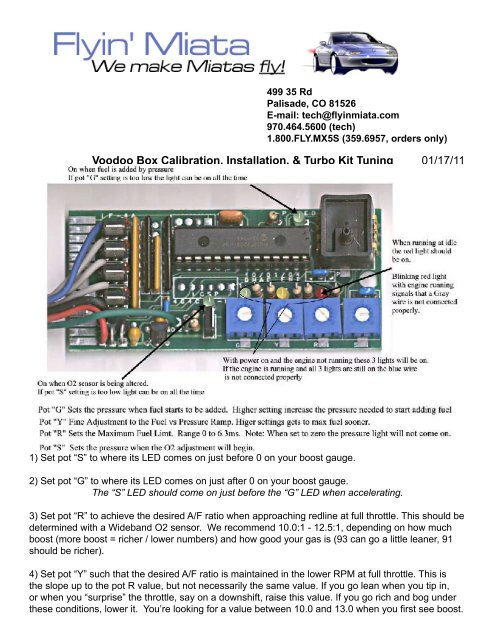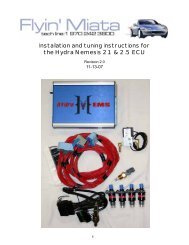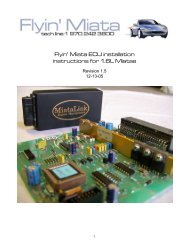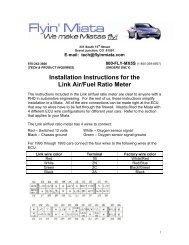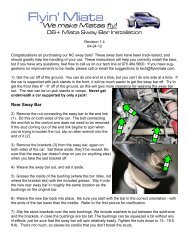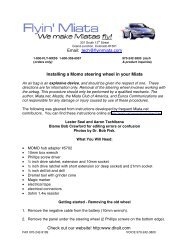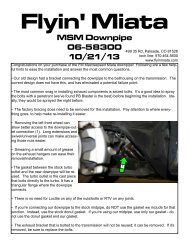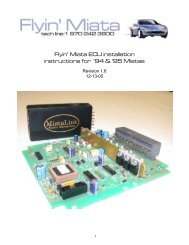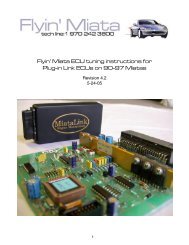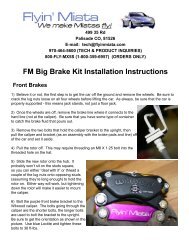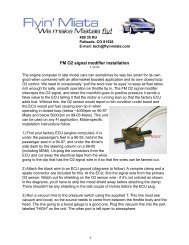Voodoo Box Calibration, Installation, & Turbo Kit Tuning 01 ... - Flyin
Voodoo Box Calibration, Installation, & Turbo Kit Tuning 01 ... - Flyin
Voodoo Box Calibration, Installation, & Turbo Kit Tuning 01 ... - Flyin
Create successful ePaper yourself
Turn your PDF publications into a flip-book with our unique Google optimized e-Paper software.
499 35 Rd<br />
Palisade, CO 81526<br />
E-mail: tech@flyinmiata.com<br />
970.464.5600 (tech)<br />
1.800.FLY.MX5S (359.6957, orders only)<br />
<strong>Voodoo</strong> <strong>Box</strong> <strong>Calibration</strong>, <strong>Installation</strong>, & <strong>Turbo</strong> <strong>Kit</strong> <strong>Tuning</strong> <strong>01</strong>/17/11<br />
1) Set pot “S” to where its LED comes on just before 0 on your boost gauge.<br />
2) Set pot “G” to where its LED comes on just after 0 on your boost gauge.<br />
The “S” LED should come on just before the “G” LED when accelerating.<br />
3) Set pot “R” to achieve the desired A/F ratio when approaching redline at full throttle. This should be<br />
determined with a Wideband O2 sensor. We recommend 10.0:1 - 12.5:1, depending on how much<br />
boost (more boost = richer / lower numbers) and how good your gas is (93 can go a little leaner, 91<br />
should be richer).<br />
4) Set pot “Y” such that the desired A/F ratio is maintained in the lower RPM at full throttle. This is<br />
the slope up to the pot R value, but not necessarily the same value. If you go lean when you tip in,<br />
or when you “surprise” the throttle, say on a downshift, raise this value. If you go rich and bog under<br />
these conditions, lower it. You’re looking for a value between 10.0 and 13.0 when you first see boost.
5) The following are values that we have found to work in cars tuned here at FM: It is however important<br />
to note that there is not a lot of consistency when it comes to dialing these in, so to be safe we<br />
highly recommend tuning the <strong>Voodoo</strong> box with a Wideband O2 sensor.<br />
<strong>Turbo</strong>- Y = 8, R = 6 Super- Y = 5, R = 4<br />
The <strong>Voodoo</strong> <strong>Box</strong> intercepts the stock injector signals. When the car is under boost, the<br />
signals are modifed to deliver more fuel. This allows the user to take advantage of the extra<br />
headroom in the factory fuelling system. Under normal driving conditions - cruise, starting,<br />
idling and the like - the injector signal is unchanged. This unit also includes an O2 spoof to eliminate<br />
lean tip-in. It does this by modifying the factory O2 sensor under boost while in closed loop.<br />
1) Disconnect the negative terminal on the battery. Find the factory ECU. It is above the clutch<br />
pedal underneath the dash on 99+ Miatas, behind the passenger seat on 94-97 cars, and under the<br />
passenger footrest on 90-93 cars. Undo the plugs attached to the ECU. The ECU harness plugs<br />
below are viewed from the harness side with the tab on top.<br />
3) Use the included butt connectors to connect the <strong>Voodoo</strong> <strong>Box</strong> to the stock<br />
ECU. You’ll need to cut the original wire, twist the appropriate <strong>Voodoo</strong> box<br />
wire around one of the cut and stripped ends, crimp it into the butt connector,<br />
then crimp the other end into the butt connector. Cut and connect one wire at a time to ensure that<br />
you don’t confuse the different wires. Once connected, give a slight tug to ensure that the wires are<br />
firmly held in the butt connector. CONFIRM YOUR CONNECTIONS WITH A MULTIMETER! If the<br />
wire color and location don’t agree with our schematics, match the location instead of the color. Once<br />
all of the wires have been connected, CAREFULLY heat shrink the new butt connectors. The heat<br />
shrink helps seal the connector and acts as a strain relief, so it’s a good thing to do. Be very careful<br />
using the heat gun, as you don’t want to melt any other wires.<br />
4) Using the supplied plastic T connector, tap into the vacuum line running to the boost<br />
gauge. Attach the new vacuum line to the <strong>Voodoo</strong> <strong>Box</strong>. MAKE SURE THIS IS SECURE!<br />
5) Use double-sided tape to attach the <strong>Voodoo</strong> <strong>Box</strong> to the stock ECU case.<br />
1999-00:<br />
<strong>Voodoo</strong> <strong>Box</strong>: ECU<br />
red: white with red stripe, pin 1B<br />
black: black with yellow stripe, pin 3A<br />
blue: yellow with black stripe, pin 3W<br />
grey: violet with green stripe, pin 3X<br />
grey: yellow with red stripe, pin 3Y<br />
grey: yellow with green stripe, pin 3Z<br />
green: blue, pin 2C<br />
20<strong>01</strong>-05<br />
<strong>Voodoo</strong> <strong>Box</strong>: ECU<br />
red: white with red stripe, pin 4AF<br />
black: black, pin 3A<br />
blue: yellow with black stripe, pin 2A<br />
grey: violet with green stripe, pin 2D<br />
grey: yellow with red stripe, pin 2G<br />
grey: yellow with green stripe, pin 2J<br />
green: blue, pin 4W
1996-97<br />
<strong>Voodoo</strong> <strong>Box</strong>: ECU<br />
red: white with red stripe, pin 4B<br />
black: black, pin 4D<br />
blue: yellow, pin 4U<br />
grey: yellow with black stripe, pin 4V<br />
grey: green with white stripe, pin 4W<br />
grey: green, pin 4X<br />
green: red with green stripe, pin 3C<br />
1994-95<br />
<strong>Voodoo</strong> <strong>Box</strong>: ECU<br />
red: white with red stripe, pin 1B<br />
black: black, pin 2B<br />
blue: yellow, pin 2U<br />
grey: yellow with black stripe, pin 2V<br />
grey: green with white stripe, pin 2Y<br />
grey: green, pin 2Z<br />
green: red with blue stripe, pin 2N<br />
1990-93<br />
<strong>Voodoo</strong> <strong>Box</strong>: ECU<br />
red: white with red stripe, pin 1B<br />
black: black, pin 2B<br />
blue: yellow, pin 2U<br />
grey: yellow with black stripe, pin 2V<br />
grey: not used, except 2Y on 93 CA cars<br />
grey: not used, except 2Z on 93 CA cars<br />
green: red with blue stripe, pin 2N<br />
There are 2 separate chips for the <strong>Voodoo</strong> <strong>Box</strong>. The reason is that the 90-93 (except 93 CA) cars<br />
were batch injection while all other Miatas are sequential injection.<br />
- 90-93 (except 93 CA)<br />
- 94-05 and 93 CA<br />
If you are attaching the <strong>Voodoo</strong> box to an OTM, use the following for your reference along with your<br />
car’s factory wiring diagram to determine the correct placement of your wires. Also, determine your<br />
chip needs based on the descriptions above.<br />
red: switched B+ from the main relay<br />
black: chassis ground<br />
blue: injector 1<br />
grey: injector 2<br />
grey: injector 3<br />
grey: injector 4<br />
green: primary O2 sensor signal
<strong>Tuning</strong> Instructions/Suggestions<br />
Now that your turbo kit and <strong>Voodoo</strong> box are installed it is time to tune your car. Fuel and timing tuning<br />
are essential for safe, powerful, and reliable operation of your turbocharged engine. There are three<br />
factors here that need to be addressed: fuel, timing, and boost pressure. All three must come together<br />
for your car to run at its best.<br />
There are certain tools that will allow you to tune your <strong>Voodoo</strong> turbo system properly. The most<br />
important tool for fuel tuning is a Wideband oxygen sensor with a display. This will allow you to<br />
precisely monitor your air/fuel ratio in real-time whereas the stock narrowband O2 sensor that comes<br />
in your car will not. (The stock NBO2 will only tell you 3 things- leaner than stoich, stoichiometric, and<br />
richer than stoich.) If you purchase your own WBO2 you can tune your <strong>Voodoo</strong> box yourself based<br />
on the recommended A/F targets listed earlier in this manual. If you do not, you can have the car<br />
tuned at a dyno shop. They will have a WBO2 attached to their dyno. Once the car is tuned properly<br />
(and we recommend a little bit conservatively) you should not have to mess with it- unless you travel<br />
somewhere that has fuel of a lower octane. In this case it is best to keep out of full throttle if you do<br />
not have the tools available to reduce your boost level or retard your timing manually.<br />
If you do not tune the <strong>Voodoo</strong> box with a WBO2 you will need to set things conservatively. You may<br />
be able to set the wastegate can to around 5 psi and run with the recommended numbers in the<br />
beginning of these instructions. You may be able to turn your fuel outputs to max and run 1-2 psi<br />
more. If at any time your car feels like it is bogging, struggling, not revving freely when you are in<br />
boost, etc. you are lean and you need to increase fuel or reduce boost immediately to prevent engine<br />
damage. Please consider this only a temporary option until you can gain access to a WBO2 for<br />
proper fuel tuning.<br />
Note- all other factors held constant, the 99-05 Miatas have more headroom in the fuel system than<br />
the 90-97 Miatas. This means that the later cars can support more boost than the earlier cars will.<br />
While I have seen the M2 cars support between 190-220 rwhp (depending on external factors), the<br />
testing (which isn’t as thorough yet) we have done on M1 cars shows support for around 140-160<br />
rwhp. If you want to eek a little more you can usually go with around a 15% larger injector- more<br />
than this limits your car’s ability to maintain a stoichiometric idle and cruise for closed loop conditions<br />
which is a problem for emissions and fuel economy. This means that 90-93 cars (blue top injector)<br />
can use 94-97 tan top injectors, 94-97 cars can use 270cc injectors, and 99-00 cars (maroon injector)<br />
can use <strong>01</strong>-05 purple injectors. We have seen <strong>01</strong>-05 cars support RWHP in the low 200s on stock<br />
injectors, and honestly if you want more power than that you should upgrade to a standalone ECU<br />
since the 6 degrees max static retard from our adjustable timing wheel will not cut it. (<strong>01</strong>-05 cars have<br />
higher compression.)<br />
Now on to timing tuning. A tool that is useful for tuning the timing on 99-05 Miata is an OBD-2<br />
scantool that has the ability to monitor voltage output from your factory knock sensor. This will detect<br />
knock long before you can hear it. If you have a 90-97 Miata or no scantool, you will have to listen for<br />
knock when tuning your timing and (assuming your A/F ratios are good) back off a couple degrees<br />
when you advance to the spot where you hear any. ALL TUNING MUST BE DONE WITH THE TOP<br />
UP AND WINDOWS UP! You’ll never hear a ping with the windows or top down. If you set up the<br />
timing in the winter you will likely have to back it off some more when it turns to summer as warmer<br />
intake temps will increase the likelihood of knock.
The <strong>Voodoo</strong> box only controls fuel. With any turbo<br />
kit you must also control your timing as stock<br />
timing is too much for boost. If you have a 90-97<br />
Miata you can dial in a static amount of timing<br />
retard by adjusting your Cam Angle Sensor and<br />
checking its position with a timing light. Refer to a<br />
service manual for how to do this. (When using a<br />
timing light jump GND to TEN in your diagnostics<br />
connector (box with the flip up lid by the driver’s<br />
side shock tower) so that you force the factory ECU into open loop.) We<br />
recommend starting with 4 degrees of timing, which is 6 degrees retarded from OEM 10 degrees.<br />
Retarding your timing will move the notch clockwise on the backing plate marks. As conditions<br />
allow, you can advance from there (bringing it back counter clockwise). For 99-05 cars we include an<br />
adjustable timing wheel with our <strong>Voodoo</strong> and <strong>Voodoo</strong> 2 kits that is slotted to allow for up to 6 degrees<br />
of static retard (verify where you are with a timing light!). You’ll need to remove the alternator and<br />
power steering belts (refer to the service manual for clarification), then remove the crank pulley. The<br />
crank pulley is removed by taking out the four M6 (10mm head) bolts (torque them back down 150<br />
in-lbs (NOT ft-lbs) when you’re done). This is NOT the big bolt in the middle. Remove the original<br />
timing wheel and reinstall the new as shown (the stamp is now a sticker). Always tighten the bolts<br />
holding the timing wheel, even if you intend to re-adjust it later. Once again, start with the max 4<br />
degrees (6 degrees retarded) and advance as much as you can while keeping it reliably south of<br />
where any knock occurs.<br />
Note- In general, we don’t recommend over 8 psi when<br />
your available retard is 6 degrees. (Maybe a little less<br />
for California, maybe a little more for Texas etc.)<br />
Remember with a static retard your off-boost timing<br />
is down as well which reduces throttle response and<br />
raises your exhaust gas temps. If you want more<br />
boost you should upgrade to a standalone ECU<br />
such as our Hydra for 90-05 Miata.<br />
rotate plate this way to retard timing<br />
(shown at maximum 6°)<br />
We have recommended boost levels for our <strong>Voodoo</strong><br />
and <strong>Voodoo</strong> 2 turbo kits, however within the nature<br />
of tuning and variability there is some fudge factor.<br />
W. E. BOWSER<br />
For example, if you live in California (the worst gas in<br />
the U.S. for turbo cars, 91 octane that is more like 89-<br />
this stamp goes on the front<br />
90) and you are tuning for the best-running car possible,<br />
you simply won’t be able to run as much boost as someone<br />
with the same car and the same kit in Texas (The best pump gas<br />
we’ve seen, 93 octane that smells like race gas). What we are hoping for with optimal tuning is to get<br />
your car to the best of its ability given its surroundings. For 90-97 cars start at 5 psi and work up from<br />
there as you tune. For 99-05 cars start at 6. If you have an intercooled kit you will simply end up tuned<br />
with more boost than you would have if you did not have the IC. Your fuel and timing tuning along with<br />
available octane should dictate the boost level that you can attain. If at any time you have questions<br />
about tuning or want to run an idea by us, feel free to call the <strong>Flyin</strong>’ Miata tech line.<br />
Now that the theory is down, here is a step by step to get you going after everything is installed and<br />
you are ready to start tuning your <strong>Voodoo</strong> turbo system. Remember to make absolutely sure that the<br />
vacuum hose into the <strong>Voodoo</strong> box is secure!
1) Set your initial boost low using washers as described in the turbo kit installation instructions.<br />
Shortening the distance between the wastegate itself (the pin coming out of the turbo) and the<br />
actuator (gold can) raises boost and lengthening the arm lowers it. We preload the arm length<br />
to around 6 psi- if you want to be conservative you may want to back it off. Test and repeat as<br />
necessary. If you lose that little C clip you’re on your way to Home Depot. A good way to avoid losing<br />
the clip is to have a magnet next to the clip when you pry it off.<br />
2) Start the car and check your timing. Set your timing as appropriate to 4 degrees of advance (as<br />
described above) as a starting point. If at any time in the procedure below you hear knock, rather<br />
than retard the timing any more you need to lower your boost. If you want more boost you’ll need a<br />
standalone ECU and larger injectors.<br />
3) With the car running, you need to set your O2 adjustment and fuel addition parameters (S and<br />
G potentiometers, respectively). Once the idle has settled down (a few seconds after starting),<br />
disconnect the vacuum line going to the Voodo box. Do NOT remove it at the <strong>Voodoo</strong> box, as<br />
(depending on the hose size) the hose might be glued on. Disconnect the hose at the barb, where it<br />
can be easily reconnected. Use something to plug the end of the line going to the engine, to ensure<br />
that you don’t have a vacuum leak. The end of the hose going to the <strong>Voodoo</strong> box needs to be open<br />
to the atmosphere. Adjust the S pot so that the light is just on and the G pot so that the light has just<br />
gone out. In other words, spin the S parameter so that the light goes out. Now adjust it back until the<br />
light turns back on, but stop as soon as it comes back on. The G pot is adjusted opposite - turn the<br />
pot until the light turns on, then turn it back so that the light has just gone out. Since the map sensor<br />
is now seeing atmospheric pressure, you’ve just adjusted the S pot to turn on just before atmospheric<br />
pressure and the G pot to turn on just after. Fine tuning may be needed, but this should be close. If<br />
one or both of the lights won’t come on regardless, this doesn’t mean you have a defective box. It<br />
just means that you have to adjust these parameters by driving and watching for 0 on your gauge.<br />
4) Once you are ready, drive the car and stay out of boost. (Having a passenger help is much safer<br />
for tuning the <strong>Voodoo</strong> box, by the way.) Turn your fuel delivery output to max output (pot R) to start<br />
on the conservative side. If you are tuning for max output you will most likely leave it there and just<br />
tweak your fuel slope (pot Y) for the midrange. 90-97 cars will most likely be at max fuel output while<br />
99-05 cars may hit 8psi and still be rich at max (meaning fuel output can be turned down to hit the<br />
desired A/F target and increase HP). Be aware that all lights will probably come on at high vacuum,<br />
that doesn’t mean anything one way or another.<br />
5) Slowly introduce boost while monitoring your boost gauge and A/F ratio. The idea here is to get<br />
as much boost as you can (within the guidelines above) while being able to maintain your target A/F<br />
ratio (first page and above) all the way to redline. One way to do this is to leave your fuel output at<br />
maximum and increase your boost on the WG actuator 1/2 turn at a time until you hit your A/F target<br />
all the way to redline. If you lean out anywhere, including at high RPM, lower your boost. Once you’re<br />
satisfied with the fueling, put the top back on the <strong>Voodoo</strong> box. Please be very careful in tightening the<br />
screws, as it’s easy to break the bottom half of the case.<br />
6) Once your fuel delivery and boost pressure is set you will determine if any more base timing can<br />
be dialed in to the system. You want the most base timing you can get while NEVER hearing any<br />
knock. Advance your timing 1 degree at a time and test. If you reach a point where you experience<br />
knock, set your timing 2 degrees retarded from that point to remain conservative. Any time you get<br />
different gas or it gets a lot warmer out listen again for knock and retard 1 degree as necessary.<br />
(Remember, each marker on your timing plate is 2 degrees. The 10 degree marker is labeled.)


